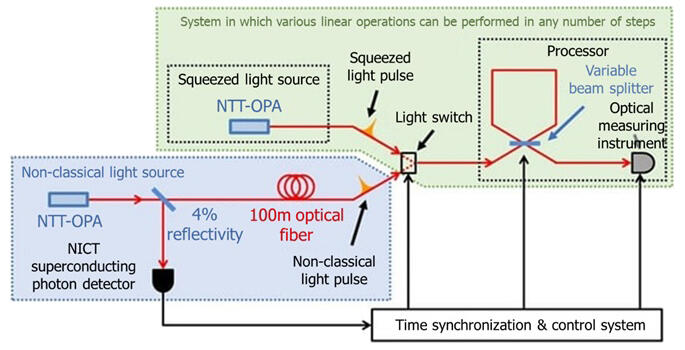A research team led by Associate Professor Shuntaro Takeda and Graduate Student Takato Yoshida (at the time of research) of the Graduate School of Engineering at the University of Tokyo, together with NTT and the National Institute of Information and Communications Technology (NICT), announced on January 17 that they fabricated the world's first general-purpose optical quantum computing platform that can compute non-classical optical pulses. Using non-classical optical pulses, which could not be utilized until now, this technology will pave the way for high-speed calculations that exceed the speed of modern computers. Furthermore, by scaling up to a system that can perform calculations using many optical pulses through an optical circuit based on their unique method that is highly scalable, it is expected that in the future an error-tolerant universal quantum computer that surpasses supercomputers can be developed.

Provided by the University of Tokyo
A typical quantum computer uses qubits, which are a superposition of 0s and 1s, as the unit of information. In contrast, a method that uses a superposition of continuous values (real number values) as the unit of information is called continuous-variable. In particular, as the amplitude and phase of light pulses have continuous values, performing calculations using continuous-variable information is possible. The research team used the same method in their study.
In recent years, research and development of optical quantum computing platforms focusing on general-purpose computing in the continuous-variable scheme of light is progressing. However, all platforms developed so far are incomplete as they are limited to linear operations and cannot compute faster than current computers. In a continuous-variable quantum computer, numerous combinations of basic operations are performed, such as entering one or two continuous values and using a certain rule to convert these values into another continuous value as the output. Operations in which the output value is a constant multiple of the input value or is a sum or difference calculated from the input and out values are called linear operations, while operations such as the multiplication of input values are called nonlinear operations. By combining linear and nonlinear operations, a quantum computer that can perform all types of calculations can be developed. Herein, the research team succeeded for the first time in the world in introducing non-classical optical pulses, which enabled linear and nonlinear operations, into an optical quantum computing platform.
A method proposed by Takeda and his colleagues in 2017, in which a single processor repeated arithmetic operations while chronologically lined optical pulses of qubits orbited a looped optical circuit, allowed for large-scale calculations to be performed using compact optical circuits. A platform was constructed by combining this processor with the source of optical pulses exhibiting strong quantum nature. Construction required a source that generated optical pulses with strong quantum nature in the wavelength band of optical communications (1545 nm), which had high affinity for optical fibers, and was realized by combining an optical parametric amplifier developed by NTT and a superconducting photon detector developed by NICT. Moreover, via repeated injections of supplementary optical pulses (squeezed light) generated by another optical parametric amplifier into this processor, they confirmed through a demonstration experiment that linear operations could be repeated in any number of steps for a single non-classical optical pulse.
Using this platform as a testbed, the research team expects to make significant progress in implementing previously unrealized nonlinear operations, evaluating quantum error correction processing, and exploring quantum applications, such as optimization and machine learning in the future.
This article has been translated by JST with permission from The Science News Ltd. (https://sci-news.co.jp/). Unauthorized reproduction of the article and photographs is prohibited.




